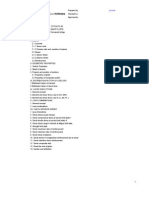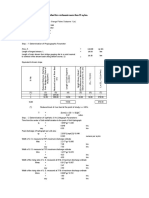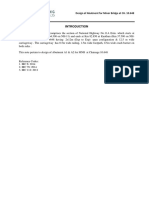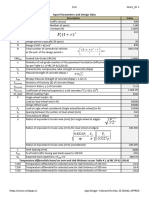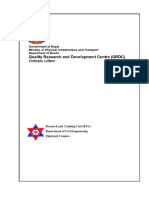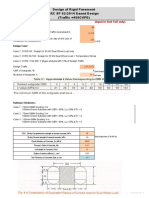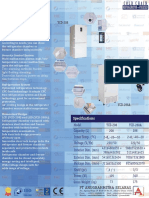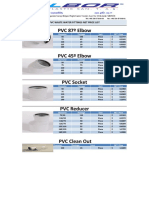Rigid Pavement Joint Design - 2020 - QRDC
Uploaded by
geoprabhatCopyright:
Available Formats
Rigid Pavement Joint Design - 2020 - QRDC
Uploaded by
geoprabhatOriginal Description:
Original Title
Copyright
Available Formats
Share this document
Did you find this document useful?
Is this content inappropriate?
Copyright:
Available Formats
Rigid Pavement Joint Design - 2020 - QRDC
Uploaded by
geoprabhatCopyright:
Available Formats
Traffic Calculation for design period
IRC 58:2015 Based Design
(Input in Red Cell only)
Design period , years 30
Annual rate of growth of commercial traffic (expre 0.065
Two-way commercial traffic volume per day (in the 2,000
% of traffic in predominant direction percent
0.50
(Lane Distribution Factor)
Traffic in predominant direction, commercial traffi 1,000
Average number of standard axles (steering/singl 2.5
Design Traffic in predominant direction, commercia78,817,063
Total day time traffic % of Total traffic in predomin 45.0%
Total day time Design Traffic 35,467,679
Total night time Design Traffic 43,349,385
Six hour day time traffic (10 AM - 4PM) @ 75% 26,600,759
Six hour night time traffic (0 AM - 6PM) 21,674,692
Design Traffic in predominant direction, commercial traffic
volume per day (For Fatigue Analysis) @ 25%
Design Traffic (for Bottom-up Cracking), K 6,650,190
Design Traffic (for Top-Down Cracking) , J 5,418,673
Analysis based on Load Spectrum Field Data No (Put YES / NO)
For Bottom-up For Top-Down
Ratio of
Axle category Cracking Analysis Cracking Analysis
total
(K x N) (J x N)
Front single axel (N1) 0.45 0 0
Rear single axle (N2) 0.15 997,528 812,801
Tandem axle (N3) 0.25 1,662,547 1,354,668
Tridem axle (N4) 0.15 997,528 812,801
Total 1.000 3,657,604 2,980,270
Front single (steering) Axles not considered
Understanding Temperature Difference Phenomenon
Developed By: Er. Prabhat Kumar Jha, SDE/QRDC/DoR
Developed By: Er. Prabhat Kumar Jha, SDE/QRDC/DoR
Design Data IRC 58:2015 Based Design
(Input in Red Cell only)
175 micron
Effective modulus Plastic Sheet
of subgrade
reaction of
Effective modulus
CBR of Thickness of Dry combined
of DLC, MPa/m Poisson's Ratio of Radius of relative
compacted 8 Lean Concrete 100 250 foundation of 220 0.15 0.876
subgrade, % (Table 4/ IRC Concrete, Mu stiffness, m
subbase, mm subgrade +
58:2015)
granular sub-base
and DLC sub-
base , MPa/m 37
PQC 0
10
Load Transfer DLC
Effective modulus Efficiency 0
Max. day-time
of subgrade PQC : 28-day 28-day Flexural Factor for TDC
Effective CBR of Temperature
reaction of Comprehensive strength of analysis, Beta
compacted 8 50 Differential in slab, 19 40 4.4 0.66 Drainage Layer 15
subgrade, % foundation, strength of cement cement concrete, = 0.66 for
0
C (for bottom-up 0
MPa/m (Table 2/ concrete, MPa MPa dowel Joints,
cracking) 0.90 for joints
IRC 58:2015)
without dowels 15
GSB as Separation Layer
0
Night-time
Effective modulus
Temperature 500mm of Sungrade with
Thickness of of Untreated Elastic Modulus of Trial Thickness of min. CBR >8%
Differential in slab, Unit weight of
Granular Subbase, 150 Subbase, MPa/m 70 6 Concrete, Ec 30000 25 Concrete Slab, h, 0.370
0
C (for top-down Concrete, kN/m3
mm (Table 3/ IRC (MPa) m
cracking) = day-
58:2015)
time diff/2 + 5
Designed Pavement Section
Developed By: Er. Prabhat Kumar Jha, SDE/QRDC/DoR
Axle Load Spectrum and Detials
Rear Single Axle Rear Tandem Axle Rear Tridem Axle
Frequency (%) Frequency (%) BUC _ TDC_ Frequency (%) BUC _ TDC_
Mid-Point of BUC _ TDC_ Mid-Point of Mid-Point of
Load Group Frequency (%) (If no Survey Load Group Frequency (%) (If no Survey Expected Expected Load Group Frequency (%) (If no Survey Expected Expected
Load Group Expected Expected Load Group Load Group
(kN) (From Survey) Data (kN) (From Survey) Data Repetitions Repetitions (kN) (From Survey) Data Repetitions Repetitions
(kN) Repetitions (ni) Repetitions (ni) (kN) (kN)
available)# available)# (ni) (ni) available)# (ni) (ni)
185-195 190 0.0 5.0 49876 40640 380 - 400 390 0.0 2.5 41564 33867 530-560 545 0.0 2.5 24938 20320
175-185 180 0.0 5.0 49876 40640 360 - 380 370 0.0 2.5 41564 33867 500-530 515 0.0 2.5 24938 20320
165-175 170 2.0 5.0 49876 40640 340 - 360 350 0.0 5.0 83127 67733 470-500 485 0.0 2.5 24938 20320
155-165 160 3.0 5.0 49876 40640 320 - 340 330 0.0 5.0 83127 67733 440-470 455 0.0 5.0 49876 40640
145-155 150 10.0 5.0 49876 40640 300 - 320 310 0.0 5.0 83127 67733 410-440 425 0.0 5.0 49876 40640
135-145 140 12.0 5.0 49876 40640 280 - 300 290 1.0 5.0 83127 67733 380-410 395 1.0 5.0 49876 40640
125-135 130 10.0 10.0 99753 81280 260 - 280 270 6.0 5.0 83127 67733 350-380 365 4.0 10.0 99753 81280
115-125 120 20.0 15.0 149629 121920 240 - 260 250 10.0 10.0 166255 135467 320-350 335 5.0 10.0 99753 81280
105-115 110 16.0 20.0 199506 162560 220 - 240 230 28.0 15.0 249382 203200 290-320 305 26.0 15.0 149629 121920
95-105 100 10.0 20.0 199506 162560 200 - 220 210 25.0 15.0 249382 203200 260-290 275 30.0 15.0 149629 121920
85-95 90 7.0 5.0 49876 40640 180 - 200 190 18.0 25.0 415637 338667 230-260 245 16.0 25.0 249382 203200
< 85 80 10.0 0.0 0 0 < 180 170 12.0 5.0 83127 67733 < 230 215 18.0 2.5 24938 20320
# Author Recommendation to include Overlaod Case too
Developed By: Er. Prabhat Kumar Jha, SDE/QRDC/DoR
Fatigue Anaysis (BUC)
Rear Single Axle Rear Tandem Axle Rear Tridem Axle
Mid-Point of BUC _ Allowable Mid-Point of BUC _ Allowable Fatigue Mid-Point of BUC _ Allowable Fatigue
Flex Stress Stress Ratio Fatigue Flex Stress Stress Ratio Flex Stress Stress Ratio
Load Group Expected Repetitions Load Group Expected Repetitions Damage Load Group Expected Repetitions Damage
MPa (SR) Damage (ni/Ni) MPa (SR) MPa (SR)
(kN) Repetitions (ni) (Ni) (kN) Repetitions (ni) (Ni) (ni/Ni) (kN) Repetitions (ni) (Ni) (ni/Ni)
190 49876 2.32 0.52 273556 0.18 390 41564 1.64 0.37 Infinity 0.00 545 24938 2.43 0.55 125203 0.20
180 49876 2.25 0.51 499665 0.10 370 41564 1.60 0.36 Infinity 0.00 515 24938 2.35 0.53 220669 0.11
170 49876 2.19 0.49 1046390 0.05 350 83127 1.56 0.35 Infinity 0.00 485 24938 2.27 0.51 438220 0.06
160 49876 2.12 0.48 2724021 0.02 330 83127 1.52 0.34 Infinity 0.00 455 49876 2.19 0.49 1045398 0.05
150 49876 2.05 0.46 10597957 0.00 310 83127 1.48 0.33 Infinity 0.00 425 49876 2.10 0.48 3429666 0.01
140 49876 1.98 0.45 Infinity 0.00 290 83127 1.43 0.32 Infinity 0.00 395 49876 2.02 0.46 22603375 0.00
130 99753 1.91 0.43 Infinity 0.00 270 83127 1.39 0.31 Infinity 0.00 365 99753 1.94 0.44 Infinity 0.00
120 149629 1.84 0.42 Infinity 0.00 250 166255 1.35 0.31 Infinity 0.00 335 99753 1.86 0.42 Infinity 0.00
110 199506 1.77 0.40 Infinity 0.00 230 249382 1.31 0.30 Infinity 0.00 305 149629 1.77 0.40 Infinity 0.00
100 199506 1.70 0.38 Infinity 0.00 210 249382 1.27 0.29 Infinity 0.00 275 149629 1.69 0.38 Infinity 0.00
90 49876 1.64 0.37 Infinity 0.00 190 415637 1.23 0.28 Infinity 0.00 245 249382 1.61 0.36 Infinity 0.00
80 0 1.57 0.35 Infinity 0.00 170 83127 1.18 0.27 Infinity 0.00 215 24938 1.52 0.34 Infinity 0.00
Total BUC 0.35 0.00 0.43
Developed By: Er. Prabhat Kumar Jha, SDE/QRDC/DoR
Fatigue Anaysis (TUC)
Rear Single Axle Rear Tandem Axle Rear Tridem Axle
Mid-Point of Allowable Mid-Point of Allowable Fatigue Mid-Point of Allowable Fatigue
TDC_ Expected Flex Stress Stress Ratio Fatigue TDC_ Expected Flex Stress Stress Ratio TDC_ Expected Flex Stress Stress Ratio
Load Group Repetitions Load Group Repetitions Damage Load Group Repetitions Damage
Repetitions (ni) MPa (SR) Damage (ni/Ni) Repetitions (ni) MPa (SR) Repetitions (ni) MPa (SR)
(kN) (Ni) (kN) (Ni) (ni/Ni) (kN) (Ni) (ni/Ni)
190 40640 1.17 0.27 Infinity 0.00 390 33867 1.19 0.27 Infinity 0.00 545 20320 1.14 0.26 Infinity 0.00
180 40640 1.14 0.26 Infinity 0.00 370 33867 1.16 0.26 Infinity 0.00 515 20320 1.11 0.25 Infinity 0.00
170 40640 1.11 0.25 Infinity 0.00 350 67733 1.13 0.25 Infinity 0.00 485 20320 1.08 0.24 Infinity 0.00
160 40640 1.08 0.24 Infinity 0.00 330 67733 1.10 0.25 Infinity 0.00 455 40640 1.05 0.24 Infinity 0.00
150 40640 1.05 0.24 Infinity 0.00 310 67733 1.06 0.24 Infinity 0.00 425 40640 1.02 0.23 Infinity 0.00
140 40640 1.02 0.23 Infinity 0.00 290 67733 1.03 0.23 Infinity 0.00 395 40640 0.99 0.22 Infinity 0.00
130 81280 0.98 0.22 Infinity 0.00 270 67733 1.00 0.23 Infinity 0.00 365 81280 0.95 0.22 Infinity 0.00
120 121920 0.95 0.22 Infinity 0.00 250 135467 0.97 0.22 Infinity 0.00 335 81280 0.92 0.21 Infinity 0.00
110 162560 0.92 0.21 Infinity 0.00 230 203200 0.94 0.21 Infinity 0.00 305 121920 0.89 0.20 Infinity 0.00
100 162560 0.89 0.20 Infinity 0.00 210 203200 0.90 0.20 Infinity 0.00 275 121920 0.86 0.19 Infinity 0.00
90 40640 0.86 0.19 Infinity 0.00 190 338667 0.87 0.20 Infinity 0.00 245 203200 0.83 0.19 Infinity 0.00
80 0 0.83 0.19 Infinity 0.00 170 67733 0.84 0.19 Infinity 0.00 215 20320 0.80 0.18 Infinity 0.00
Total BUC 0.00 0.00 0.00
Cummulative Datigue Damage (Sum of above) 0.79
Safe Design
Developed By: Er. Prabhat Kumar Jha, SDE/QRDC/DoR
Design of Panel Size
IRC 58:2015 Based Design
(Input in Red Cell only)
Input Data
Concrete Strength, fck 40 MPa
Tensile Strength of Concrete, σ at 0.08 MPa
Coefficient of Friction, f 1.5
Density of Concrete 25 KN/m3
Slab Thickness, h 370 mm
Width of Panel 3.5 m <4.5m, Safe
Required Length of Panel 4.3 m
Adopted Length of Panel 4.5 m <4.5m, Safe
Skematic Drawing
4.5 m
3.5 m
Developed By: Er. Prabhat Kumar Jha, SDE/QRDC/DoR
Design of Dowel Bar
IRC 58:2015 Based Design
(Input in Red Cell only)
Input Data
Slab Thickness, h 370 mm
Joint width, z 20 mm (For expansion Joint)
(5mm for Contraction Joint/Construction Joint)
Modulus of Subgrade Reaction, k 220 MPa/m
Modulus of Elasticity of Bar, E 200000 MPa
Modulus of Dowel Support, k mds 415000 MPa/m
Poisson's Ratio 0.15
Radius of Relative Stiffness, l 876 mm (Calculated)
Maximum Single Axle Load 190 KN
Maximum Single Wheel Load 95 KN
Load Transfer % at Terminal Stage 0 (30% for Tied Shoulder, otherwize, ZERO)
Wheel Load for Dowel Design 95 KN
% of Load Transfer through the Dovel Bar 50 ( 50 for 100% Joint Efficiency)
Load to be transferred, P 47.5 KN (Load shared by the dowels within l distance)
Dia. of Dowel Bar 38 mm (Plane Bar only)
Length of Dowel Bar 500 mm
Spacing of Dowel Bar, s 200 mm
Placement of first dowel 150 mm (From Pavement Edge)
Concrete Strength, fck 40 MPa
Permissible Bearing Stress in Concrete, 26.71 MPa
Analysis
95
c
c
Pt = 17.48
150 200 200 200 76 (Symbolic Sketch only )
y2 y3
y1
1 y0 Dowel Bar No. Ordinate
1 y0 1.000
2 y1 0.772
3 y2 0.543
4 y3 0.315
5 y4 0.087
6 y5 0.000
7 y6 0.000
Sum 2.717
Pt 17.48 (Maximu Force on Bar 1)
Check for Bearing Stress
Moment of Inertia of Dowel Bar 102353.9 mm4
Relative Stiffness of Dowel Bar embedded in Concrete, β 0.021 mm-1
Bearing Stress in Dowel Bar , F bmax 23.31 Mpa
Assumed Dowel Bar Size and Spacing is Safe
Developed By: Er. Prabhat Kumar Jha, SDE/QRDC/DoR
Skematic Drawing
500
Dia. of Dowel
Bar 38
500
Dia. of Dowel
Bar 38
155 155
105 105
Developed By: Er. Prabhat Kumar Jha, SDE/QRDC/DoR
Design of Tie Bar
IRC 58:2015 Based Design
(Input in Red Cell only)
Input Data and Analysis
Slab Thickness, h 0.370 m
Lane Width, b 3.5 m
Coefficient of Friction, f 1.5
Density of Concrete 25 KN/m3
Allowable Tensile Stress 200 MPa (Deformed Bar, As per IRC 15:2011)
Allowable Bomd Stress 2.46 MPa (Deformed Bar))
Dia. of Tie Bar 12 mm
Bar Area, Ab 113 mm2
Area of Bar required per meter, As 243 mm2 / m
No. of Bar required 3.15
Spacing of Bar required 466 mm
Spacing of Tie Bar adopted, s 400 mm
Safe
Required Length of Tie Bar 487.8049 mm
Increase length by 100mm for Loss of Bond due to painting and another 50mm for tolerance in placement
Provided Length of Bar 650 mm
Skematic Drawing
Dia. of Tie
Bar 12 650
Developed By: Er. Prabhat Kumar Jha, SDE/QRDC/DoR
Developed By: Er. Prabhat Kumar Jha, SDE/QRDC/DoR
You might also like
- Fluid Mechanics Applications: Irrigation Systems0% (1)Fluid Mechanics Applications: Irrigation Systems5 pages
- Locked DESIGN SHEET FINAL ARUN-SATYENDRA 11.06.2019No ratings yetLocked DESIGN SHEET FINAL ARUN-SATYENDRA 11.06.20195 pages
- Short Reinforcement Long Reinforcement: +ive in Span Due ToNo ratings yetShort Reinforcement Long Reinforcement: +ive in Span Due To14 pages
- Pavement Design WMM Stablized Iit Pave1 TTNo ratings yetPavement Design WMM Stablized Iit Pave1 TT16 pages
- Chirai Anjar Rigid Pavement Design As Per IRC 58 201167% (3)Chirai Anjar Rigid Pavement Design As Per IRC 58 201160 pages
- Effective Width Method: Sheets ReferenceNo ratings yetEffective Width Method: Sheets Reference14 pages
- Detailed Analysis of Pre-Cast Box Segment and Thrust Bed and Thrust Wall Using Staad ProNo ratings yetDetailed Analysis of Pre-Cast Box Segment and Thrust Bed and Thrust Wall Using Staad Pro6 pages
- Pavement Design WMM Stablized Iit Pave1No ratings yetPavement Design WMM Stablized Iit Pave125 pages
- LOT1 CONCRETE Mixes 27-03-2019 - REV 9.1No ratings yetLOT1 CONCRETE Mixes 27-03-2019 - REV 9.17 pages
- Pile For Abutment A-1: Bridge & Roof Co. (I) LTDNo ratings yetPile For Abutment A-1: Bridge & Roof Co. (I) LTD12 pages
- Aizawal-Tuipang (NH-54) - PKG 6: Design Notes-Retaining WallNo ratings yetAizawal-Tuipang (NH-54) - PKG 6: Design Notes-Retaining Wall114 pages
- Dual Carriageway Roads 4 Lane Carriageway: Click On The Type of PavementNo ratings yetDual Carriageway Roads 4 Lane Carriageway: Click On The Type of Pavement18 pages
- Rigid Pavement Design As Per IRC 58 2011 Axle Load SpectrumNo ratings yetRigid Pavement Design As Per IRC 58 2011 Axle Load Spectrum1 page
- Synthetic Unit Hydrograph Method For Catchments More Than 25 SQ - KMNo ratings yetSynthetic Unit Hydrograph Method For Catchments More Than 25 SQ - KM7 pages
- Thulo Neti Khola Bridge - Abutment Design: Fig: Abutment (All Dimensions in Metres)No ratings yetThulo Neti Khola Bridge - Abutment Design: Fig: Abutment (All Dimensions in Metres)4 pages
- KBW BC-74+235 RCC Design Report (BC-1X2X2.5) NewNo ratings yetKBW BC-74+235 RCC Design Report (BC-1X2X2.5) New16 pages
- Design of Abutment For Minor Bridge at CH. 10.648No ratings yetDesign of Abutment For Minor Bridge at CH. 10.64834 pages
- Abutment A1 On Counterfort Wall - 03.07.2020 1.04 PMNo ratings yetAbutment A1 On Counterfort Wall - 03.07.2020 1.04 PM34 pages
- Design of PCC Toe Wall: Sin Sin 1 Cos Cos CosNo ratings yetDesign of PCC Toe Wall: Sin Sin 1 Cos Cos Cos2 pages
- NEW JESRSY - GFRP Crash Barrier Friction SlabNo ratings yetNEW JESRSY - GFRP Crash Barrier Friction Slab9 pages
- Detailed Project Report Development of Industrial Area,: at Piparsewa, Dist - MorenaNo ratings yetDetailed Project Report Development of Industrial Area,: at Piparsewa, Dist - Morena44 pages
- ETABS Composite Column Design: ETABS 18.0.2 License # 1PJPHBGNRCE4GAWNo ratings yetETABS Composite Column Design: ETABS 18.0.2 License # 1PJPHBGNRCE4GAW2 pages
- Determine Rock Mass Properties Through Hoek-Brown Criteria (Reference Only)No ratings yetDetermine Rock Mass Properties Through Hoek-Brown Criteria (Reference Only)40 pages
- Rigid Pavement Joint Design - 2020 - QRDC (Less Than 450CVPD)No ratings yetRigid Pavement Joint Design - 2020 - QRDC (Less Than 450CVPD)9 pages
- Mid Term Review of Sector Wide Road Programme & Priority Investment Plan 1No ratings yetMid Term Review of Sector Wide Road Programme & Priority Investment Plan 192 pages
- Guage Thickness in MM Weight Per Sq. Ft. Weight Per Pc. Kgs. Pc. IN M/TonNo ratings yetGuage Thickness in MM Weight Per Sq. Ft. Weight Per Pc. Kgs. Pc. IN M/Ton3 pages
- PT 9 Naval Ships Technology Vol 2 Guidelines For Hull Structures and Ship EquipmentNo ratings yetPT 9 Naval Ships Technology Vol 2 Guidelines For Hull Structures and Ship Equipment5 pages
- Deko GV: Double Glazed Partition With High Sound ReductionNo ratings yetDeko GV: Double Glazed Partition With High Sound Reduction14 pages
- KIL1773 - 221214 - SF - Winchburgh, Structural Survey, 15 Station ViewNo ratings yetKIL1773 - 221214 - SF - Winchburgh, Structural Survey, 15 Station View36 pages
- PVC 87º Elbow: PVC Waste Water Fittings Net Price ListNo ratings yetPVC 87º Elbow: PVC Waste Water Fittings Net Price List2 pages
- NDP-5 Specifications: Port Dimensions (3.1 GPM Max.)No ratings yetNDP-5 Specifications: Port Dimensions (3.1 GPM Max.)7 pages
- Ceraflux-11 Pink Powder For Aluminum FoundryNo ratings yetCeraflux-11 Pink Powder For Aluminum Foundry1 page
- Study On Design Method of Shear Buckling and Bending PDFNo ratings yetStudy On Design Method of Shear Buckling and Bending PDF10 pages
- Find A Library Where Document Is AvailableNo ratings yetFind A Library Where Document Is Available3 pages
- Locked DESIGN SHEET FINAL ARUN-SATYENDRA 11.06.2019Locked DESIGN SHEET FINAL ARUN-SATYENDRA 11.06.2019
- Short Reinforcement Long Reinforcement: +ive in Span Due ToShort Reinforcement Long Reinforcement: +ive in Span Due To
- Chirai Anjar Rigid Pavement Design As Per IRC 58 2011Chirai Anjar Rigid Pavement Design As Per IRC 58 2011
- Detailed Analysis of Pre-Cast Box Segment and Thrust Bed and Thrust Wall Using Staad ProDetailed Analysis of Pre-Cast Box Segment and Thrust Bed and Thrust Wall Using Staad Pro
- Aizawal-Tuipang (NH-54) - PKG 6: Design Notes-Retaining WallAizawal-Tuipang (NH-54) - PKG 6: Design Notes-Retaining Wall
- Dual Carriageway Roads 4 Lane Carriageway: Click On The Type of PavementDual Carriageway Roads 4 Lane Carriageway: Click On The Type of Pavement
- Rigid Pavement Design As Per IRC 58 2011 Axle Load SpectrumRigid Pavement Design As Per IRC 58 2011 Axle Load Spectrum
- Synthetic Unit Hydrograph Method For Catchments More Than 25 SQ - KMSynthetic Unit Hydrograph Method For Catchments More Than 25 SQ - KM
- Thulo Neti Khola Bridge - Abutment Design: Fig: Abutment (All Dimensions in Metres)Thulo Neti Khola Bridge - Abutment Design: Fig: Abutment (All Dimensions in Metres)
- Abutment A1 On Counterfort Wall - 03.07.2020 1.04 PMAbutment A1 On Counterfort Wall - 03.07.2020 1.04 PM
- Detailed Project Report Development of Industrial Area,: at Piparsewa, Dist - MorenaDetailed Project Report Development of Industrial Area,: at Piparsewa, Dist - Morena
- ETABS Composite Column Design: ETABS 18.0.2 License # 1PJPHBGNRCE4GAWETABS Composite Column Design: ETABS 18.0.2 License # 1PJPHBGNRCE4GAW
- Determine Rock Mass Properties Through Hoek-Brown Criteria (Reference Only)Determine Rock Mass Properties Through Hoek-Brown Criteria (Reference Only)
- Rigid Pavement Joint Design - 2020 - QRDC (Less Than 450CVPD)Rigid Pavement Joint Design - 2020 - QRDC (Less Than 450CVPD)
- Mid Term Review of Sector Wide Road Programme & Priority Investment Plan 1Mid Term Review of Sector Wide Road Programme & Priority Investment Plan 1
- Guage Thickness in MM Weight Per Sq. Ft. Weight Per Pc. Kgs. Pc. IN M/TonGuage Thickness in MM Weight Per Sq. Ft. Weight Per Pc. Kgs. Pc. IN M/Ton
- PT 9 Naval Ships Technology Vol 2 Guidelines For Hull Structures and Ship EquipmentPT 9 Naval Ships Technology Vol 2 Guidelines For Hull Structures and Ship Equipment
- Deko GV: Double Glazed Partition With High Sound ReductionDeko GV: Double Glazed Partition With High Sound Reduction
- KIL1773 - 221214 - SF - Winchburgh, Structural Survey, 15 Station ViewKIL1773 - 221214 - SF - Winchburgh, Structural Survey, 15 Station View
- PVC 87º Elbow: PVC Waste Water Fittings Net Price ListPVC 87º Elbow: PVC Waste Water Fittings Net Price List
- NDP-5 Specifications: Port Dimensions (3.1 GPM Max.)NDP-5 Specifications: Port Dimensions (3.1 GPM Max.)
- Study On Design Method of Shear Buckling and Bending PDFStudy On Design Method of Shear Buckling and Bending PDF


















